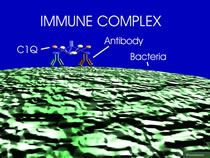U.C.L.A. Rheumatology Pathophysiology of Disease Course Lecture,
Second Year Medical School 1997
Systemic Lupus Erythematosus Page 8
When the antibodies bind to their targets they either destroy them or alter their function. Antibodies binding to platelets and red blood cells result in their accelerated removal by the reticuloendothelial system causing respectively thrombocytopenia and Coomb's positive hemolytic anemia. Those attaching to lymphocytes may alter their function resulting in further immunologic abnormalities.
An important group of antibodies are directed against phospholipids. These antibodies may alter the clotting mechanism and provoke arterial and venous thrombosis as well as thrombosis and infarction of the placenta in pregnant patients resulting in mid-trimester abortions. Antibodies against ribosomal P proteins may be linked to neuropsychiatric symptoms.
When antibodies bind to freely circulating antigen, they form immune complexes. Small complexes are formed in antigen excess and large complexes in antibody excess. Small complexes circulate in the blood stream for a prolonged period but they cause relatively little tissue damage because they are not capable of activating the complement cascade. Large complexes activate complement readily, but they also do not cause much damage because they are rapidly cleared from the circulation by the reticuloendothelial system of fixed tissue macrophages. When intermediate-sized complexes are formed, then "circulating immune complex disease" occurs. In SLE these are typically DNA-antiDNA complexes. These complexes are large enough to

igure 1. An immune complex is formed by the act of antibody binding to antigen, which can result in activation of complement. Click thumbnail figure to view full graphic. jpeg 210 x 178 pixels 17kbs